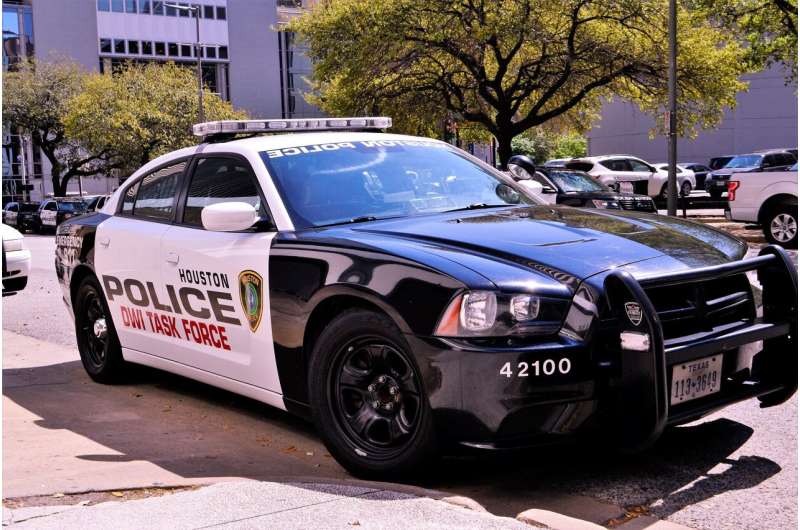Intensive training of police leads to reduced crime, fewer arrests and more positive interactions

Scientists at the National Policing Institute, George Mason University, Arizona State University, and University of Pennsylvania conducted a study with joint support from Arnold Ventures and the National Policing Institute. The study has now been published in the Proceedings of the National Academy of Sciences (PNAS).
Can training police officers in procedural justice reduce crime and improve the community's perceptions of the police? An intensive, randomized controlled trial conducted in high-crime places (or "hot spots") produced evidence that training officers to operate according to the principles of procedural justice changed officer behavior, reduced arrests, and reduced crime. Perceptions of the police on the streets where these officers worked also improved during the study. The findings are good news for police, community leaders, and others who seek ways to reduce crime while simultaneously improving police-community relations.
Procedural justice is based on four components of fairness and equality: giving people a voice, showing neutrality, treating people with respect, and showing trustworthy motives. Observations of officer-community interactions found that trained officers were significantly more likely to behave in procedurally just ways.
For leaders who are looking for ways to control crime while also improving relations between the police and the community, the study's findings provide important information about a strategy that can be implemented broadly.
"This significant scientific experiment confirms that it is possible to simultaneously reduce crime and improve police-community relationships through improved training and supervision. Further, this intervention—procedural justice training to improve officers' community interaction skills—is especially powerful because it can benefit all officers and improve police-community interactions generally. We owe a debt of gratitude to the officers, supervisors and agency leaders in the study who cooperated fully with data collection and all the experimental conditions. Their willingness to engage and support the scientific process is emblematic of their commitment to improved policing," said Jim Burch, President of the National Policing Institute.
"As our nation continues to grapple with the social impacts of the pandemic and a spike in homicides, it is critical that we build a body of evidence about what works to reduce community violence," said Walter Katz, Vice President of Criminal Justice at Arnold Ventures. "This research shows that public safety and policing that is respectful of all community members are interconnected goals. Police departments across the country should learn from these results and require high-quality procedural justice training as a core component of any hot spot crime reduction program."
"The release of this research comes at an extremely pertinent time when many across the country are taking a closer look at police training," said Ann Ardis, Dean of George Mason University's College of Humanities and Social Sciences. "Professor Weisburd's work in partnership with the National Policing Institute and Arnold Ventures adds high-value scientific evidence to the national conversation around policing."
"There are only a small number of randomized experiments examining the influence of police training, and even fewer that look at effects of training on both officer behavior and community perceptions. This study adds to the evidence base for procedural justice training and expands our understanding of how training impacts interactions between police and the public. We view our findings as important for efforts to enhance both fairness and effectiveness in policing," said Cody Telep, associate professor in the School of Criminology and Criminal Justice at Arizona State University, and one of the authors of the study.
The multi-year study was conducted in three cities: Tucson, Arizona; Houston, Texas; and Cambridge, Massachusetts. In those cities, more than 1,000 hours of observations and more than 1,500 surveys of residents helped to confirm how the training of officers impacted outcomes. Across the three study sites, 28 police officers were randomly assigned to two groups: the intervention group, which received 40 hours of intensive training in procedural justice concepts and the practical use of the approach, and the control group, which received no procedural justice training and followed standard operating procedures. The officers were allocated randomly to 120 crime hot spots in the three cities and studied for an average of nine months in each site.
The study team collected a variety of data: self-reports before and after the training to assess whether the training influenced officer attitudes; systematic observations of officers to understand how the training impacted officer behaviors while interacting with the community; arrest data to assess law enforcement actions; household surveys before and after the training to assess resident attitudes toward the police; and official crime reports.
More information: David Weisburd et al, Reforming the police through procedural justice training: A multicity randomized trial at crime hot spots, Proceedings of the National Academy of Sciences (2022). DOI: 10.1073/pnas.2118780119
Journal information: Proceedings of the National Academy of Sciences
Provided by National Policing Institute





















